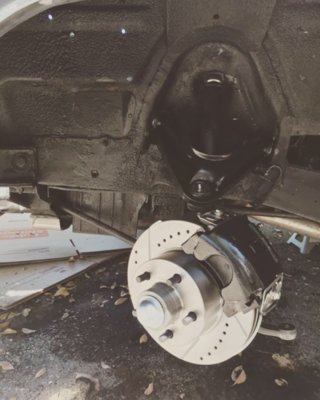Rck68
Well-Known Member
guys, do you know the torque spec for the front axle nut? I just converted to disc brakes on my 68 charger.
Thanks so much for the help!
Thanks so much for the help!
I wouldn't go higher than 90 inch/pounds. The smaller A body spec is 70 in/lbs. Similar procedure for all cars, tighten to spec and back off slightly.
http://www.mymopar.com/downloads/servicemanuals/1969_Charger_Coronet_Dart_Service_Manual.zip

Ok thank you so much, I’ve been seeing upwards of 160 to even 190 for certain cars. But couldn’t find anything on b bodies. This is again for a 68 charger. Want to get it right first time
View attachment 929563
Yes thank you I set it at 7.5 foot lbs, just snug!Just to make sure 90 inch pounds is 7.5 foot pounds... your 160 or even 190 is likely a modern vehicle an is foot pounds... Because the bearings are a completely different design... On a modern car all your doing is clamping a fixed bearing cartridge to the spindle... On vintage stuff you are actually adjusting the bearing... Don't crank down on it or you'll destroy the bearings...
This is a "rolling" torque. You turn the rotor/hub while you apply the 90 inch lbs. of torque. Doing this sets the rollers where they need to be in the races and sets the preload.
If you torque a taypered roller bearing without rotating them it could result in not having the correct preload and or cause damage to the bearing and race.
This is a video I made doing front wheel bearings and I did a little experiment on torqueing the bearings. Skip to the 7:20 mark...
Funny thing you reminded me of...Just to make sure 90 inch pounds is 7.5 foot pounds... your 160 or even 190 is likely a modern vehicle an is foot pounds... Because the bearings are a completely different design... On a modern car all your doing is clamping a fixed bearing cartridge to the spindle... On vintage stuff you are actually adjusting the bearing... Don't crank down on it or you'll destroy the bearings...
Funny thing you reminded me of...
I never use a torque wrench on front wheel bearings. I've always tightened them until they feel right, spin the rotor...tighten a bit or loosen, etc. I have never had one fail. It isn't scientific but it works for me.
A buddy of mine though....
He went through TWO sets of wheel bearings, blaming their failure on Chinese parts he got from Magnum Farce suspension.
I'd never set out to defend those idiots but this buddy of mine was complaining about how he followed the instructions and torqued them to spec.
Me: " You actually torqued them? To what spec ?"
Him: "90 ft/lbs"
Me: "WTF ??? That is not right, man...."
I got my 1970 Charger manual and showed him that it was INCH lbs.
The look on his face was funny as heck.
Lol yea as soon as you said the spec, I immediately converted to inch pounds. I’m like yea 7.5 foot pounds makes more senseFunny thing you reminded me of...
I never use a torque wrench on front wheel bearings. I've always tightened them until they feel right, spin the rotor...tighten a bit or loosen, etc. I have never had one fail. It isn't scientific but it works for me.
A buddy of mine though....
He went through TWO sets of wheel bearings, blaming their failure on Chinese parts he got from Magnum Farce suspension.
I'd never set out to defend those idiots but this buddy of mine was complaining about how he followed the instructions and torqued them to spec.
Me: " You actually torqued them? To what spec ?"
Him: "90 ft/lbs"
Me: "WTF ??? That is not right, man...."
I got my 1970 Charger manual and showed him that it was INCH lbs.
The look on his face was funny as heck.
The Goldilocks Zone.I'm with the rest if you guys, never used a torque wrench for the spindle nuts. Spin the rotor and torque the nut tull you have a slight drag. Back the nut off a flat and pull in and out on the rotor or hub. If it's loose, tighten it up a flat and try again. There should be a slight preload, not loose, not tight.
